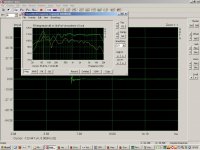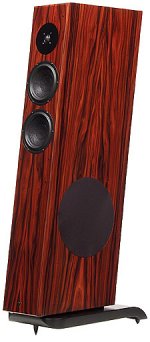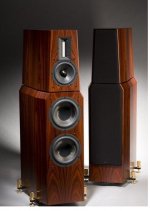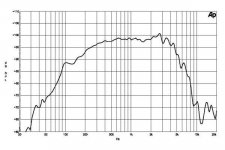This might do it, but they only have one in stock (and it would be stressing the driver at 200 Hz):
https://solen.ca/pub/index.php?cata...u1=1&niveau2=15&niveau3=15&s1=2&s2=1&s3=4&s4=
https://solen.ca/pub/index.php?cata...u1=1&niveau2=15&niveau3=15&s1=2&s2=1&s3=4&s4=
Last edited:
While this option will also add 15 cm in height ((I already calculate.
Although the frequency responce much smoother.
Although the frequency responce much smoother.
Why need separate xrossover for each? And different also
Do a search on "comb filtering".
The basic idea behind a 1.5 driver approach is using the ".5" to fill-in lower in the midrange for baffle step loss correction, or to simply correct for natural pressure losses from the driver "above" it. (..it adds about 3 db.)
Ex. 1st 165 with its low-pass around 5 kHz, 2nd 165 with its low pass around 700 Hz. It's going to be about as high as the 4-driver array of 4" Audax's though.
Last edited:
Regard to the driver of small diameters. I became convinced by experience that the only large diameter drivers can realize the scale and effect of dissolving in space. Drivers of small diameter makes the high localization of the point from which the sound comes.
Do a search on "comb filtering".
The basic idea behind a 1.5 driver approach is using the ".5" to fill-in lower in the midrange for baffle step loss correction, or to simply correct for natural pressure losses from the driver "above" it. (..it adds about 3 db.)
Ex. 1st 165 with its low-pass around 5 kHz, 2nd 165 with its low pass around 700 Hz. It's going to be about as high as the 4-driver array of 4" Audax's though.
It`s good idea. But what driver You means?
Regard to the driver of small diameters. I became convinced by experience that the only large diameter drivers can realize the scale and effect of dissolving in space. Drivers of small diameter makes the high localization of the point from which the sound comes.
I've heard designs that both do and do not characterize this. 😉
..any-way, I've spent enough time on this thread. 😱
It`s good idea. But what driver You means?
What I'd just expressly stated was *2* 165 GMF's.
Still, you do have the height prob.s.
I never heard the PHL but heard really good comments about those drivers, and since the founder of PHL is one of the designer of the Audax, I doubt you can go wrong with the audax or the phl. However, for my experience, the audax is the most natural, detailed, smooth mid I have ever heard.
Here's the measurments of the pr170mo I have taken close miced. its perfectly flat from 400hz to 6khz where it crosses to a supertweeter. The green line that is
Here's the measurments of the pr170mo I have taken close miced. its perfectly flat from 400hz to 6khz where it crosses to a supertweeter. The green line that is
Attachments
Last edited:
If you believe the plots is better option would be an old AUDAX HT210T0.
But I was alarmed always the case when a very low price. Very Low!
I always think about cheese in a mousetrap))
As for pr170mo then it is better pr170Zh0. But the first and second have not enough wide range for my goal, and a very fast roll off!
http://www.cadaudio.dk/ht210t0.pdf
http://www.cadaudio.dk/pr170z0.pdf
But I was alarmed always the case when a very low price. Very Low!
I always think about cheese in a mousetrap))
As for pr170mo then it is better pr170Zh0. But the first and second have not enough wide range for my goal, and a very fast roll off!
http://www.cadaudio.dk/ht210t0.pdf
http://www.cadaudio.dk/pr170z0.pdf
I recommend only the mo version.If you believe the plots is better option would be an old AUDAX HT210T0.
But I was alarmed always the case when a very low price. Very Low!
I always think about cheese in a mousetrap))
As for pr170mo then it is better pr170Zh0. But the first and second have not enough wide range for my goal, and a very fast roll off!
http://www.cadaudio.dk/ht210t0.pdf
http://www.cadaudio.dk/pr170z0.pdf
you should reconsider your xo point, 200hz might be too low.
But the recommended by the manufacturer low point of intersection 500 Hz is too high and is not suitable for my purposes.
What are the opinions about my choice?
With respect to the height..
You can make the design with the 12" AE drivers on the *sides* of the cabinet. Doing this would provide a few benefits, but most notably allow you the height you want.
If you wanted to improve time-alignment the whole front baffle could be "tilted" backward with the two 12" drivers opposed on either side of the loudspeaker near bottom front corners. Somewhat like the Vienna Acoustics Strauss as seen below (though likely shorter and deeper), but with the 12" drivers moved closer to the front and bottom.
Attachments
Location woofers on the side of the speaker has a negative aspect. And not one. The first - between two speakers should not be anything. Second - if the highest frequency above 100 Hz, you will hear that the sound is produced incorrectly from the side.With respect to the height..
You can make the design with the 12" AE drivers on the *sides* of the cabinet. Doing this would provide a few benefits, but most notably allow you the height you want.
If you wanted to improve time-alignment the whole front baffle could be "tilted" backward with the two 12" drivers opposed on either side of the loudspeaker near bottom front corners. Somewhat like the Vienna Acoustics Strauss as seen below (though likely shorter and deeper), but with the 12" drivers moved closer to the front and bottom.
Furthermore, two AE 12 SBP needs sealed box more than 100 liters.
I will do separate cabinets for the low-frequency section also for other drivers. It will be like this one loudspeaker:
So, and what to do? The PHL - no good. The supravox - no good too. What else? Audax?
AER? Voxative?
B&C 8PE21 ?
Attachments
B&C 8PE21 ?
It's pointless Elias. He has too many design limitations. 😱
It's a classic case of "I want" but without understanding how to "get there" properly.
- Status
- Not open for further replies.
- Home
- Loudspeakers
- Multi-Way
- Supravox 215 vs PHL 2540



